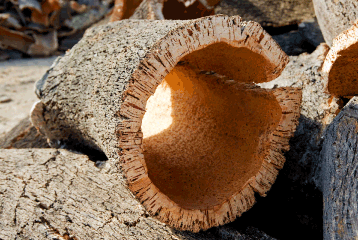Caribbean Interior Deccorations NV
Caribbean Interior Deccorations NV



Cork is the outer bark of the cork oak tree, Quercus Suber, which grows mainly in the Mediterranean region. The bark is a vegetal tissue composed of an agglomeration of cells filled with a gaseous mixture similar to air and lined with alternating layers of cellulose and suberin. Cork’s elasticity, combined with its near-impermeability, makes it the perfect material for making bottle stoppers, floor tiles, insulation sheets, bulletin boards and other similar products. Because of its remarkable qualities, cork is used in high-tech applications including car engines, dam mechanisms and airport runways. The aeronautics has used cork as a thermal insulator in space shuttles.
The use of cork as a raw material dates back to Phoenician and Greek times. Cork began to become known all over the world as an effective bottle stopper for wine. In fact, cork is the only material that makes a perfect seal during the ageing of the wine.
Today, cork is a valuable resource for Portugal, representing one of its most important export products.
Cork oak forests cover approximately 2.5 million hectares across the Mediterranean region and most of them are located in seven countries: Portugal, Algeria, Spain, Morocco, France, Italy and Tunisia.
The tree has a life span of 250-350 years. Each cork tree must be 20 to 25 years old before it can provide its first harvest of cork bark. This cork is known as virgin and has a hard and irregular structure. After the virgin cork has been stripped, a new layer of cork begins to grow.
The first of these layers, harvested after nine years, is called secondary cork; cork harvested after this second stripping is known by the Portuguese word: amadia.
A typical tree produces several hundred kilograms of cork at each harvesting and will survive for many generations. The bark is stripped off the tree in sections by highly skilled men using special axes, a traditional manual skill that dates back many hundreds of years.
Cork is harvested on a sustainable basis and the stripping of the bark does not harm the tree in any way. The bark grows back completely, taking on a smoother texture after each harvest. A cork oak tree can be safely harvested up to 20 times during its life cycle, making cork a truly inexhaustible natural resource.New plantations of cork oak trees are planted each year to ensure the level of cork production is maintained. Cork oak trees cannot be felled or removed without government authorization, which is rarely granted.
Portugal, which produces more than 50% of the world’s cork, has been particularly careful to safeguard this valuable resource.
The first Portuguese laws protecting cork oak trees date back to the 14th century. At the beginning of the 20th century, it became illegal to cut down cork oak trees, except for essential thinning or the removal of old, non-productive trees.
In a context of increasing concern for the environment, cork remains the only tree whose bark can regenerate itself after each harvest – leaving the tree unharmed. It is truly a renewable, environment.


CID Cork floor tiles are comparable to parquet but with the added benefits of insulating against both temperature and noise. Imagine the perfect floor…beautiful to look at, yet easy to care for…quiet, soft and warm to the touch, yet durable enough to handle all kinds of traffic – pets, children, high heels… fashionable and fits any decor, yet insulates against sound, noise and temperature change.
Cork, as a natural product, warms and enriches any interior. Cork flooring always blends in well with other decorations and furniture and comes in a wide range of colors, from its familiar honey tones to green, red, chocolate and black. As well, production of CID Cork flooring is environmentally friendly. No cork trees are cut down, only the bark is peeled without destroying the tree, and it grows back within nine years, ready to be harvested again.
CID Cork coverings are of the finest quality resulting from strictly supervised production and on-going quality control procedures. Cork floors have all the advantages of a natural cork product: elastic, anti-static, sound absorbing, insulating, and anti-allergenic.
Whether in a child’s room, family room, music room, kitchen, or bathroom – a cork floor is always the correct choice. It is tough, resilient and water resistant. It absorbs sound and provides acoustical excellence. Being highly abrasion resistant, these floors are often also used in public buildings including schools, hospitals, restaurants, hotels, shops and offices.
The Cork Natural Cork floor comes in a variety of designs and colors. These tiles can be arranged in different patterns to add style to any room. These floors offer excellent sound absorption and acoustical excellence as well as being tough, water resistant and resilient.
Cork flooring radiates warmth and atmosphere, allowing you to express your personal taste freely. Installation is easy. Tiles are available either with untreated surface finish to which flooring urethane (we recommend waterbased) needs to be applied after installation, or pre-finished with urethane. Either case will bring pleasing results.
Besides being decorative, 
Cork Decor floors also posses the following features: